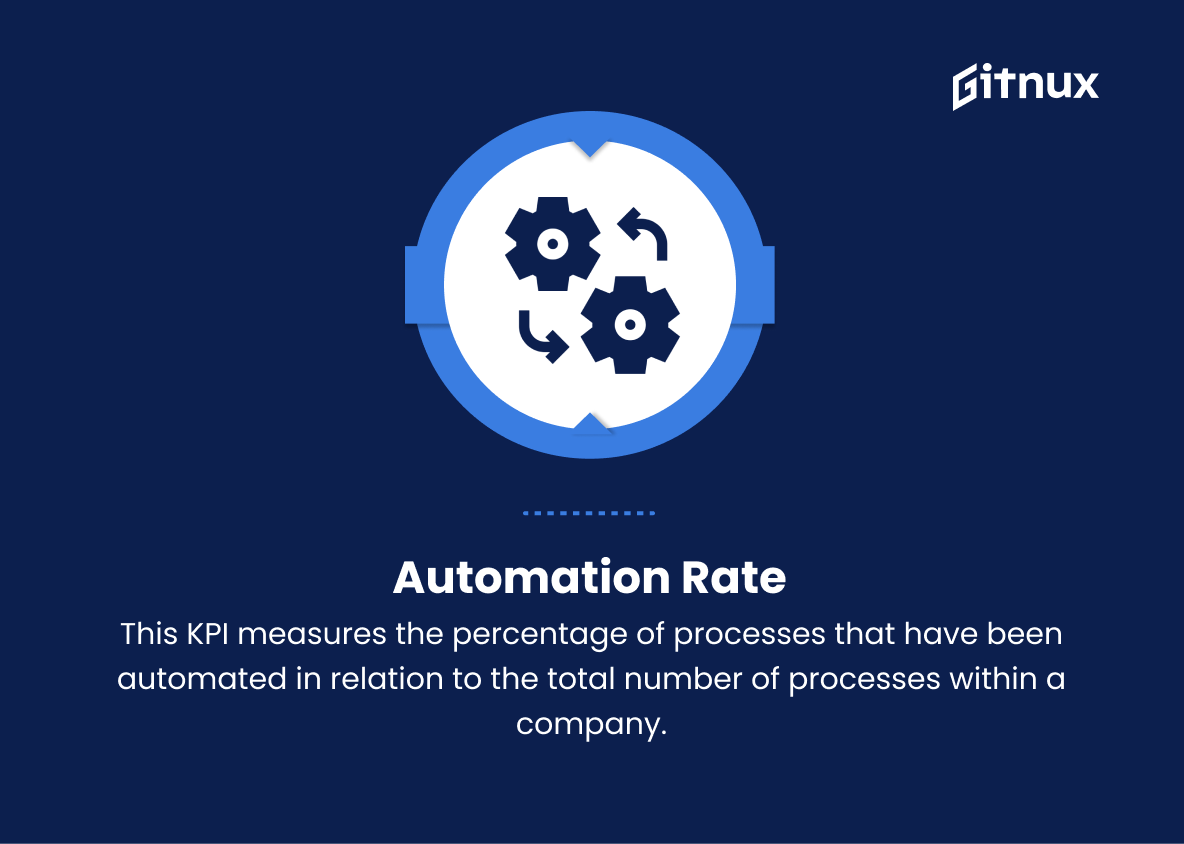In today’s rapidly evolving technological landscape, automation has emerged as a crucial driving force for businesses to streamline processes, reduce costs, and enhance efficiency. As an increasing number of organizations embark on their automation journey, it’s imperative to measure and monitor the success of these initiatives through precise and comprehensive metrics – the Automation Key Performance Indicators (KPIs).
In this insightful blog post, we will delve into the vital role of Automation KPIs in ensuring the effectiveness of your automation strategy, explore the most critical KPIs that should be on your radar, and discuss best practices to optimize your automation deployment and achieve measurable results. Join us as we unlock the full potential of automation and demonstrate how the right KPIs can make all the difference in steering your business towards sustainable growth and unprecedented success.
Automation KPIs You Should Know
1. Automation Rate
This KPI measures the percentage of processes that have been automated in relation to the total number of processes within a company. It helps identify the automation potential of the company and track progress over time.
2. Process Automation Efficiency
This metric evaluates the efficiency of the automated processes by comparing the time and resources required for completion before and after automation. It highlights the overall productivity improvements achieved through automation.
In today’s rapidly evolving technological landscape, automation has emerged as a crucial driving force for businesses to streamline processes3. Return on Investment (ROI)
ROI measures the financial benefits gained by automation against the money invested in the technology, training, and implementation. A higher ROI indicates that automated processes have effectively reduced costs and increased profits.
4. Error Rate Reduction
This KPI tracks the decrease in errors in the automated processes compared to manual processes. A reduction in errors is crucial for maintaining high-quality output and customer satisfaction.
5. Execution Time Reduction
This metric gauges the time saved by automating a process compared to manual execution. The reduced execution time enhances efficiency by freeing up resources for other tasks or enabling faster results.
6. Scalability of Automated Processes
Scalability measures the ability of the automation system to manage additional workload as the company grows. High scalability enables the company to expand its operations without additional manual effort.
By closely monitoring metrics such as task completion time, accuracy, cost savings, and employee satisfaction, organizations can make data-driven decisions to optimize their automation strategy further.7. Cost Savings
This KPI highlights the cost reductions achieved through automation by comparing the total cost before and after automation, taking into account labor, materials, and other operational expenses.
8. Satisfaction Levels
This KPI measures the satisfaction levels of employees and customers as a result of the automation efforts. Improved satisfaction indicates that automation has successfully increased the overall ease and effectiveness of the processes.
9. Cycle Time Reduction
Cycle time refers to the total time taken to complete a process from start to finish. This KPI measures the reduction in cycle time due to automation, thus indicating an improvement in overall efficiency.
10. System Reliability
This metric assesses the reliability and stability of the automated system, including its ability to handle exceptions, uptime, and recovery capabilities. High system reliability ensures that automation benefits are sustained over time.
11. Maintenance and Support Costs
This KPI tracks the ongoing costs of maintaining and supporting automated systems, such as software updates, bug fixes, and technical support. Reduced maintenance costs indicate long-term cost savings from automation investments.
12. Employee Retraining and Adaptability
This KPI measures the ability of employees to adapt to automation and the time and resources spent on retraining them for new roles. Efficient retraining and adaptability ensure a successful transition to automation and reduce resistance from employees.
Automation KPIs Explained
Automation KPIs play a crucial role in evaluating the effectiveness and impact of automation on a company’s overall performance. By measuring aspects such as Automation Rate, Process Automation Efficiency, and ROI, businesses can determine whether their automation investments are yielding desired results. KPIs like Error Rate Reduction, Execution Time Reduction, Scalability, and Cycle Time Reduction highlight the improvements in quality, efficiency, and growth potential.
Monetary gains from automation can be tracked through Cost Savings and Maintenance and Support Costs, ensuring that long-term financial benefits are realized. Furthermore, Satisfaction Levels, System Reliability, and Employee Retraining and Adaptability serve as vital indicators of the overall success of automation efforts, showcasing the automation’s impact on employees and customers alike. In summary, these Automation KPIs help companies make informed decisions and adjustments to optimize their automation strategies and achieve a competitive edge.
Conclusion
In conclusion, effectively tracking and analyzing Automation KPIs is crucial for businesses to understand the true impact of their automation efforts. By closely monitoring metrics such as task completion time, accuracy, cost savings, and employee satisfaction, organizations can make data-driven decisions to optimize their automation strategy further.
Incorporating these KPIs in regular reporting not only highlights successes and areas for improvement but also helps to communicate the value of automation to key stakeholders. Ultimately, a well-defined set of Automation KPIs enables businesses to achieve operational efficiency, drive innovation, and maintain a competitive edge in today’s rapidly evolving digital landscape.













